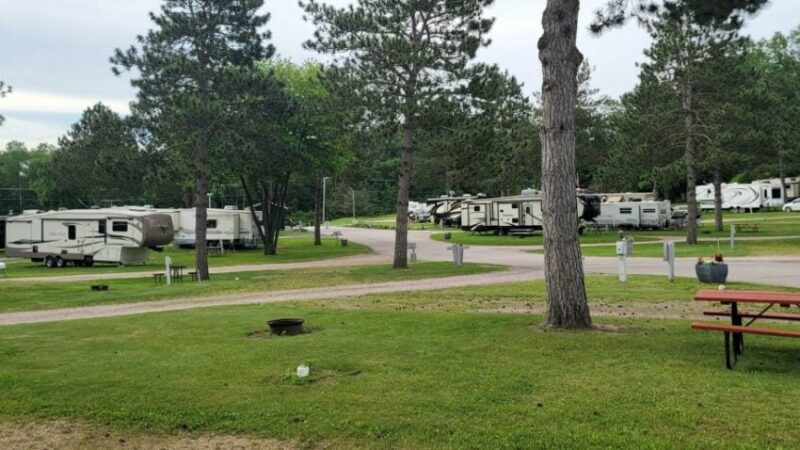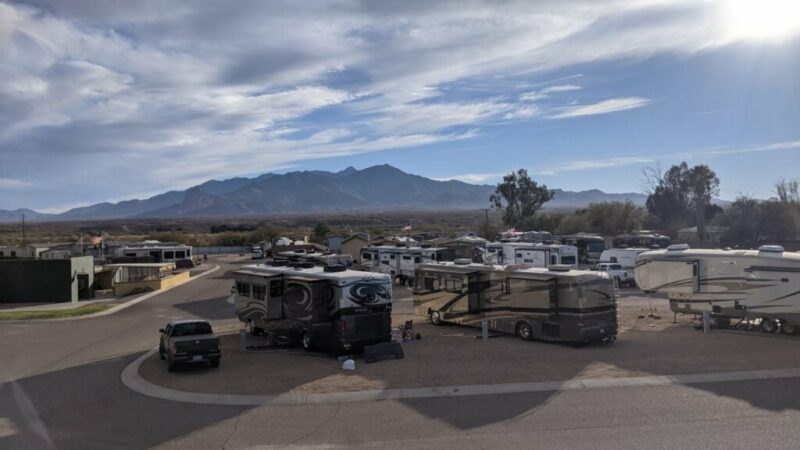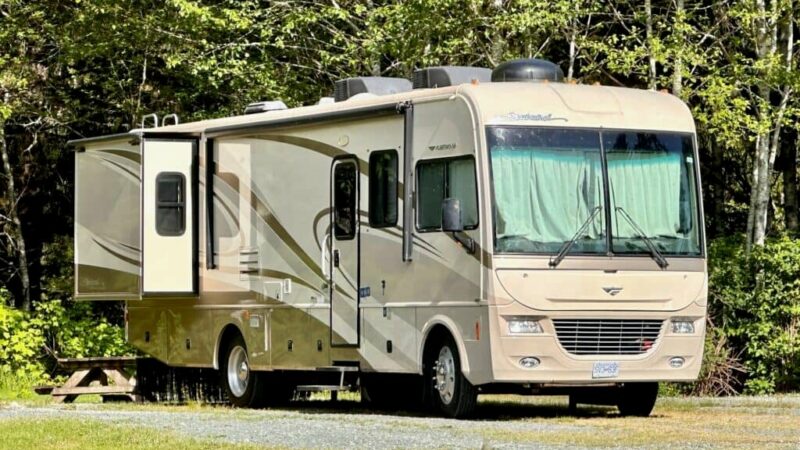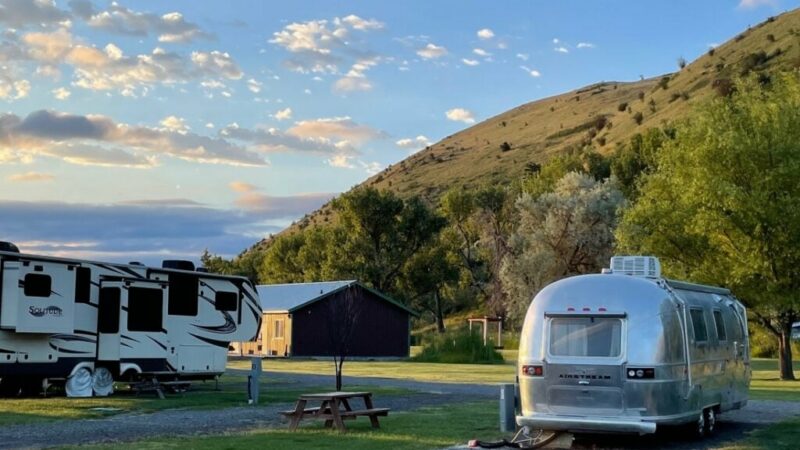RV Towing Through Traffic Circles and Roundabouts is Nothing to Fear
When you tow a car behind your motorhome, you have to rethink the way you drive. This is especially true when RV towing through traffic circles and roundabouts. These circular intersections are already tricky when driving passenger car drivers. But when you’re pulling a tow car, the challenge to avoid crashes only grows.
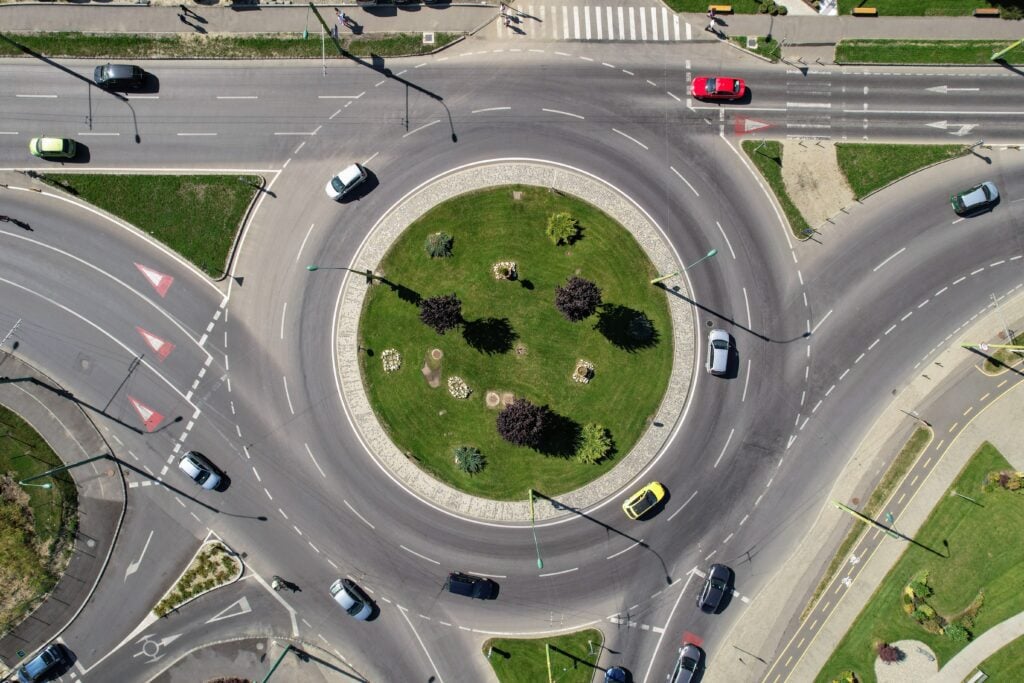
But don’t let these traffic calming devices scare you. With preparation and practice, you can tow through them safely and without fear. Here’s how.
Tips and Techniques for Maneuvering in Traffic Calming Circles With a Tow Car
When you tow a car behind a motorhome, you’ll hear it referred to as a “towed car.” But, you’ll also hear it called a “dinghy” and (most entertainingly) a “toad.” There are three ways to tow a car behind a motorhome flat towing, or using a tow dolly, or car hauler. Each choice has pros and cons, and each affects your RV’s overall weight, length, handling, and required breaking distance. For example, you’ll need to compensate for wider turns and give more time for safe breaking on roadways and when RVing through roundabouts and traffic circles.
For a deeper discussion about towing behind a motorhome, see the Camper Smarts article “3 Ways to Tow a Car Behind a Motorhome.”
Is That a Roundabout or Traffic Circle? What’s the Difference?
The traffic calming device known as “roundabouts,” “rotaries,” or “traffic circles” are common throughout the United Kingdom, France, Quebec, and older regions of the United States. In western states, they’re a relatively new innovation just since 1990.
Both roundabouts and traffic circles reduce injury crashes by directing traffic around a central island. But instead of controlling traffic flow with with traffic signals, vehicles move in, around, and out of the circle. But how they do it is where things differ. According to highway safety experts at the City of Raleigh, North Carolina:
The traffic circle is larger than the roundabout and normally includes stop signs or traffic signals that will stop traffic inside the circle. Dupont Circle in Washington, DC, is an excellent example of a traffic circle. Drivers enter a traffic circle straight on with a stop sign or traffic signal. Traffic circles can become congested if traffic signals allow too many vehicles to enter at the same time.
Roundabouts; What You Should Know, City of Raleigh, North Carolina
These roadway fixtures are not just meant to annoy drivers.
Traffic circles and roundabouts control the direction of traffic. This way, the street is a safe place for every driver, cyclist, and pedestrian who needs to get somewhere. Traffic circles, multi and single-lane roundabouts reduce neighborhood congestion. They drastically reduce traffic delays at intersections, and minimize the risk of impact crashes better than traditional intersections.
A main feature of the modern roundabout is a raised central island. The circular shape is designed to control the direction of traffic and reduce speeds to 15 to 20 mph. It also reduces the likelihood of t-bone (right angle) or head-on collisions.
Roundabouts, Washington State Department of Transportation
In most of your RV traveling, you will encounter the larger traffic circles (also known as a modern roundabout). Let’s look at how they are designed, and how to move your RV and toad through them.
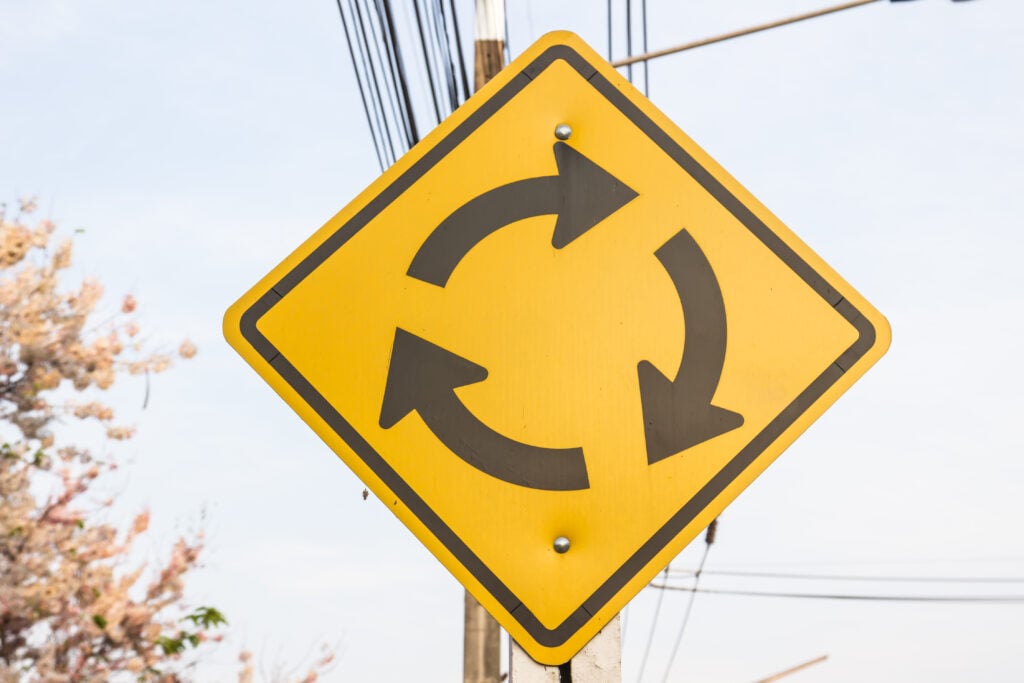
What are the Rules of Traffic Circles?
Traffic laws vary from country to country and even between regions within a country. However, the rules of roundabouts and traffic circles are basically the same anywhere you go.
In fact, we can see this by comparing the “how to use a roundabout” guides from two countries; one from the Washington State Department of Transportation in the US and two more from the governments of Alberta and Ontario in Canada. There are of course some minor differences. But overall, the information is more or less the same.
Traffic circles come in two main types: single-lane and multi-lane.
How to Use a Single-Lane Traffic Circle
Single-lane traffic circles are mostly found in residential areas and are easy to use. Simply wait for a break in cars, enter the traffic circle, and leave using your desired exit.
How to Use Multi-Lane Traffic Circles
Multi-lane traffic circles usually have two lanes.
In multi-lane traffic circles the right lane is for making a right turn (that is, taking the first exit relative to you) and usually also going straight (the exit directly across from where you enter). The extra lane on the left is for taking any other exit, including going straight.
When using a traffic circle while towing a car, you are likely to take up space in both lanes. Make sure that both lanes of traffic are clear before entering.
- When entering a multi-lane traffic circle, look for a sign that indicates which lanes are for which exits.
- Know which exit you want, use your right turn signal, and get into the correct lane.
- Once you enter multi-lane roundabouts, you must stay in that lane until you exit.
- Yield to any oncoming traffic, and when there is an opening, enter the traffic circle.
Many traffic circles will also feature what’s known as a “truck apron.” This is an extra ring of slightly raised concrete around the center island of a roundabout. This truck apron provides extra space to maneuver your RV.
10 Safety Tips for RV Towing Through a Traffic Circle
Whether you are driving or RVing through a traffic circle, there are some essential safety tips you should always keep in mind:
- When entering a traffic circle, yield to oncoming drivers. Never enter the roundabout unless you’re sure you have enough room.
- Always watch for pedestrians in crosswalks and yield to emergency vehicles when entering and exiting a traffic circle. Both have right-of-way over you.
- Remember that when you have a towed car, your vehicle is longer than smaller vehicles. Make sure to account for your extra size.
- Never stop in a traffic circle unless it’s absolutely necessary, such as to avoid causing or being a part of an accident.
- Remember that the extra mass of the toad means your vehicle will have to work extra hard to speed up and slow down.
- Always drive slowly and use caution inside traffic circles.
- Keep your space between you and other vehicles, especially large vehicles, in order to avoid collisions.
- Know what lane you need before you enter the roundabout, and then stay in it until you exit. Never change lanes in a roundabout.
- The traffic in a traffic circle always moves counterclockwise.
- If you miss your exit, you’ll have to continue all the way around the roundabout again. To avoid rear-end collisions, do not brake suddenly or turn sharply if you miss your exit.
And that’s all there is to it! Keep these 10 simple tips in mind the next time you go through a traffic circle with a towed car, and you’ll be in and out with ease.
RVing Through Traffic Circles is Nothing To Be Afraid Of
Getting through a traffic circle or roundabout can be an intimidating task. And even more so when driving an RV with a towed car behind. But the reality is that traffic circles are great! They’re a fairly simple, highly efficient refuge from chaotic intersections. Best of all, they direct traffic so that it’s safer for you, for bicyclists, and pedestrians.
The important thing is to be prepared; advance knowledge of the rules for RVing through traffic circles makes getting through them much easier. The same goes for knowing how your towed car affects your vehicle and its handling.
As long as you’re prepared, you’ll have nothing to worry about when it comes time to tackle a traffic circle with your dinghy!
The post RV Towing Through Traffic Circles and Roundabouts is Nothing to Fear appeared first on RV LIFE.



